Overview of the earliest potato varieties: detailed descriptions and characteristics
What gardener does not want to taste young potatoes planted and grown with their own hands as soon as possible? Naturally, in order to get an early harvest, you need to plant early varieties, and you always want to get more and tastier. And for this (in order to choose the right one), you need to know which early potato varieties are considered the most tasty and productive.
Note! After the quantitative characteristics of each variety, recommendations are given for the growing regions.
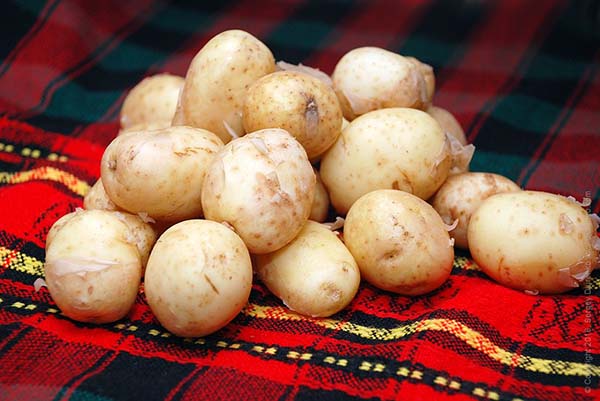
Content
Classification of potato varieties by maturity
Worth knowing! Ripening period is the time period from the first shoots to full ripening of the fruit.However, you can dig in potatoes for food 15-20 days earlier, although in this case you will receive only 50-60% of the maximum yield.
According to the ripening period, all potato varieties, as a rule, are divided into:
- very early (60-70 days);
- early (70-80 days);
- medium early (80-90 days);
- medium or mid-season (90-110 days);
- medium late (110-120 days);
- late (120-140 days).
Note! In most cases, all early varieties can be dug in already on the 45th day after full germination (by this time you can get about 50-70% of the average yield of the variety), and on the 55th day - up to 80-90% of the yield varieties.
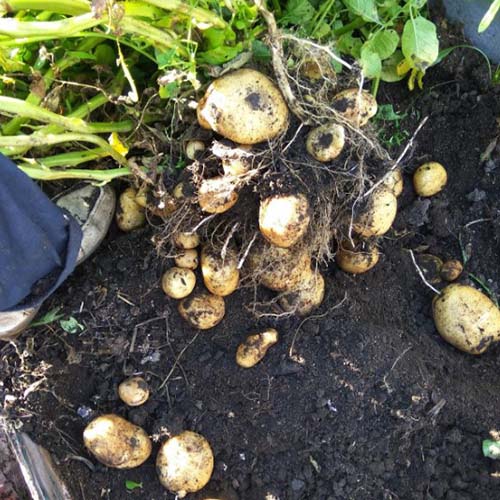
This review will only focus on the best very early and early potato varieties.
Advice! In your garden, it is optimal to grow several varieties of potatoes of different ripening periods at once: this way, during the summer you can enjoy early potatoes (early and medium varieties), and in the fall you can dig out a harvest that will stored until next year (middle and late varieties).
Early varieties of potatoes: what are the features of its cultivation (pros and cons)
The advantages of planting and growing early potato varieties:
- As mentioned earlier, this is a very early summer harvest.
- Requires less maintenance as have a short growing season.
- The ability to grow two crops (under favorable climatic conditions).
- Early varieties are less likely to suffer from late blight, because they are collected well before the onset of the active phase (peak) of the disease.
- Early ripening varieties are by no means inferior in terms of basic characteristics (yield, taste), and in terms of the latter, they often surpass their average or late counterparts.
The only drawback: for long winter storageI only medium, medium late and late varieties are suitable.
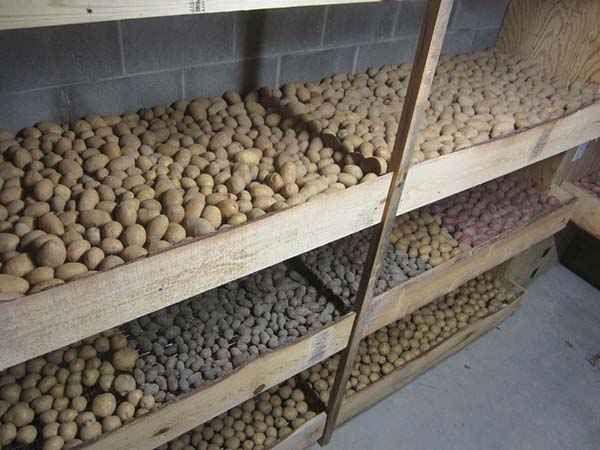
Very early potato varieties: top 2
It just so happened that there are not so many very early varieties (6), and there are only 2 tested and most positive ones.
Interesting! The first grade Meteor is recommended for planting in the Urals and Western Siberia, but the Kolomba variety does not have such a permit (only the Middle strip and the surrounding regions).
Meteor
Very early variety, for table use, high yield, good taste.
Good adaptability to any agro-climatic conditions, heat and drought resistance. It prefers to grow on loamy soil.
Resistant to the causative agent of potato cancer, nematode. Relatively resistant in leaves and highly resistant in tubers to the causative agent of late blight, moderately resistant to wrinkled and banded mosaics, common scab and rhizoctonia. Resistant to mechanical damage.
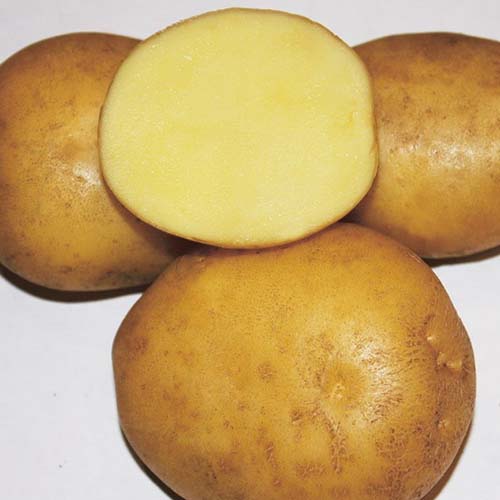
It is characterized by good taste and low digestibility. Culinary type VS. The pulp does not darken during cooking. Suitable for all kinds of dishes. Recommended for frying and baking.
Characteristics of the Meteor variety:
- ripening period - very early (60-70 days);
- the shape of the tubers is oval-round;
- the structure of the peel is smooth;
- peel color - yellow;
- pulp color - light yellow;
- the depth of the eyes is shallow to medium;
- starch content - 12.0-14.9%;
- yield per hundred square meters - 209-404 kg (maximum up to 450 kg);
- the number of tubers per bush - 10-12;
- the average weight of 1 tuber is 102-147 g;
- marketability - 88-98%;
- keeping quality - 95%.
The appearance of the plant is tall, intermediate type, semi-erect. Medium-sized leaf, dark green. The intensity of anthocyanin coloration on the inner side of the corolla is absent or very weak. Inflorescences are small, white. Berry formation is rare.
Recommended for planting regions: Central, Volgo-Vyatka, TsChO (Central Black Earth Region), Middle Volga, Ural, West Siberian, Far Eastern.
Patent holder and / or originator of the variety: FGBNU “All-Russian Research Institute of Potato Farming named after A.G. Lorkha (Russia).
Colomba (Colombo)
Very early variety, for table use, high yield and good taste.
Gives good performance when grown on loams and chernozem with low acidity.
The variety must be planted only in well-warmed soil, so there is no need to rush to planting. It needs additional application of magnesium and manganese to the soil. It responds well to watering.
Resistant to the causative agent of potato cancer, nematode. Moderately susceptible to late blight pathogen.
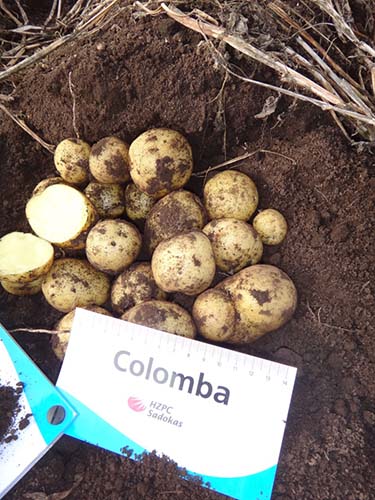
Taste good or great. When boiling or roasting, the tubers do not fall apart and retain their shape. Suitable for any type of heat treatment.
Characteristics of the Colomba variety:
- ripening period - very early (60-70 days);
- the shape of the tubers is oval-round;
- the structure of the peel is smooth;
- peel color - yellow;
- the color of the pulp is yellow;
- the depth of the eyes is shallow to medium;
- starch content - 11.0-15.0%;
- yield per one hundred square meters - 224-422 kg;
- the number of tubers per bush - up to 12;
- the average weight of 1 tuber is 82-126 g;
- marketability - 81-98%;
- keeping quality - 95%.
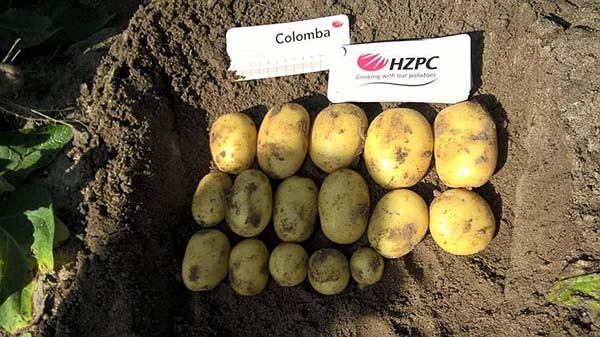
The appearance of the bushes is a plant of medium height, leaf type, from semi-erect to spreading. Medium to large green leaf. The intensity of anthocyanin coloration on the inner side of the corolla is absent or very weak. Inflorescences are red-violet.
Regions recommended for planting: North-West, Central, Volgo-Vyatka, Central Black Earth Region, North Caucasian.
Patent holder and / or originator of the variety: HZPC Holland B.V. (Holland).
Other very early varieties
Naturally, there are also other less popular, but very early (60-80 days) potato varieties:
- Capri;
- Nandina (relative to other varieties, it is still popular and recognized by many summer residents);
- Red Sonya;
- Charoite.
By the way! In some classifications there is intermediate group (very early to early), which includes 2 not very well-known varieties: Biogold and Lady Claire.
The best early potato varieties: top 14
But there are a lot of varieties of potatoes with an early (70-80 days) ripening period. Therefore, we offer you an overview of the best early varieties, which, judging by the numerous reviews, are highly appreciated by many summer residents and have long been used for industrial purposes by agricultural companies.
Alyona
An early variety, for table use, good yield and taste.
The variety has a stable yield, a consistent return of early production, drought tolerance and suitability for mechanized cultivation technology.
Responds very well to germination.
Resistant to the causative agent of potato cancer, susceptible to nematode. Susceptible to late blight. Resistant to common scab, rhizoctonia.
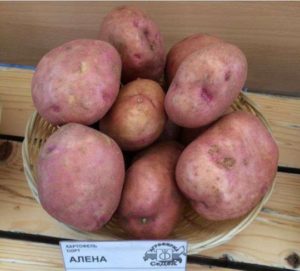
The taste is good. Culinary type VS. The digestibility is moderate. The pulp does not darken. Suitable for soups, frying. Suitable for making crispy potatoes and French fries.
Characteristics of the Alena variety:
- ripening period - early (70-80 days);
- tubers are oval;
- the structure of the peel is smooth;
- peel color - red;
- the color of the pulp is white;
- the depth of the eyes is shallow;
- starch content - 15-17%;
- yield per hundred square meters - 172-292 kg (maximum up to 391 kg);
- the number of tubers per bush - 6-10;
- the average weight of 1 tuber is 86-167 g;
- marketability - 81-97%;
- keeping quality - 95%.
The appearance of the plant - bushes of medium height, intermediate type, spreading. The leaf is large, wide, green. No or very slight waviness in the edge. Inflorescences are medium-sized, reddish-purple. Berry formation is very rare.
Recommended for planting regions: Volgo-Vyatka, Ural, West Siberian, East Siberian, Far East.
Patent holder and / or originator of the variety: Federal State Budgetary Scientific Institution "Omsk ANC" (Russia).
Bellarosa (Bella Rose or White Rose)
A variety of early ripening, table use, good yield and taste.
Interesting! Due to the specific bright red color of the peel in Russian-speaking countries, it received a popular name - Cherry potatoes.
The variety is not picky about moisture and perfectly tolerates hot periods without loss of fruit quality. Any type of soil is suitable except for heavy loamy soil.
Advice! It is advisable to germinate before planting. Positively responds to fertilization.
In most cases, it manages to bloom by the time a massive amount of the Colorado potato beetle appears. Also, the variety is resistant to the causative agent of potato cancer and nematodes. It tolerates transportation well.
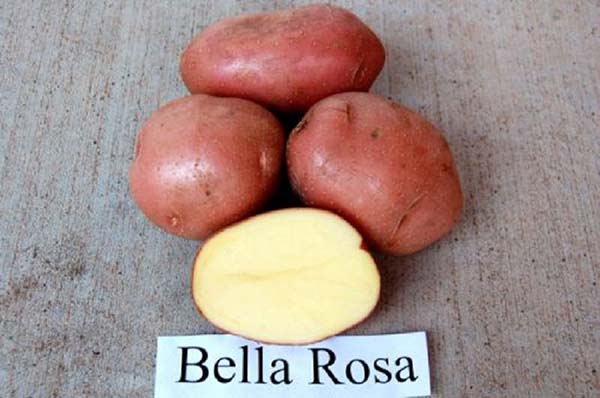
The taste is good. During the cooking process, the pulp becomes crumbly.
Young potatoes can be dug in on the 45th day after germination.
Characteristics of the Bellarosa variety:
- ripening period - early (70-80 days);
- the shape of the tubers is oval-round;
- the structure of the peel is rough;
- peel color - red;
- pulp color - light yellow;
- the depth of the eyes is shallow or medium;
- starch content - 12.6-15.7%
- yield per one hundred square meters - 169-326 kg (maximum up to 385 kg);
- the number of tubers per bush - 8-9;
- the average weight of 1 tuber is 117-207 g;
- marketability - 82-99%;
- keeping quality - 93%.
The appearance of the plant - forms tall erect shoots, with large green leaves. The inflorescences are medium and have a red-purple hue.
Regions recommended for planting: North-West, Volgo-Vyatsky, Central Black Earth Region, Uralsky.
Patent holder and / or originator of the variety: Europlant Pflanzenzucht GmbH (Germany).
Vineta (Veneta)
An early variety for table use, medium yield and good taste.
Suitable for growing in regions with harsh climates.
Resistant to the causative agent of potato cancer and nematodes. Susceptible to late blight pathogen in tops, moderately susceptible to tubers. Resistant to wrinkled and banded mosaic viruses, leaf curling, drought tolerant.
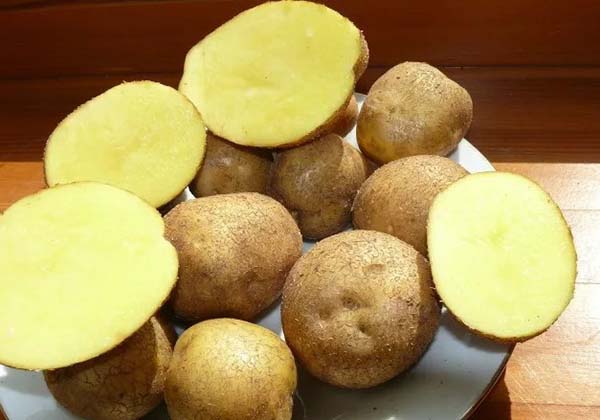
The taste is good and excellent. Culinary type B. In the process of cooking, Veneta does not boil over (boil-through is low), therefore it is recommended for preparing salads.
Note! Excessive application of nitrogen to the soil negatively affects the keeping quality of fruits.
Characteristics of the Vineta (Veneta) variety:
- ripening period - early (70-80 days);
- the shape of the tubers is oval-round;
- the structure of the peel is slightly reticulate;
- peel color - yellow;
- pulp color - light yellow;
- the depth of the eyes is shallow;
- starch content - 12.9-15.2%;
- yield per hundred square meters - 160-228 kg (maximum up to 238 kg);
- the number of tubers per bush - 10-12;
- the average weight of 1 tuber is 67-95 g;
- marketability - 87-97%;
- keeping quality - 87%.
The appearance of the plant is spreading. The leaf is light green. Low to medium waviness. Corolla small to medium in size, white inflorescences.
Recommended for planting regions: Central, Volgo-Vyatka, TsChO, North Caucasian, Srednevolzhsky, Uralsky.
Patent holder and / or originator of the variety: Europlant Pflanzenzucht GmbH (Germany).
Zhukovsky early
An early variety for table use, high yield and medium flavor.
It perfectly adapts to changing climatic conditions, is relatively heat and drought resistant. The yield is stable.
Important! Zhukovsky grows amicably even in poorly warmed soil, so the variety can be safely planted at the end of April.
Resistant to potato crayfish and nematodes. Susceptible to tops and tubers to the causative agent of late blight. The tubers are resistant to mechanical damage.
The taste is satisfactory and good. Culinary type B. The boil-off is weak. During the cooking process, the pulp darkens slightly. Great for frying, making French fries, and making chips. Can be used for puree and cooking, but not very suitable.
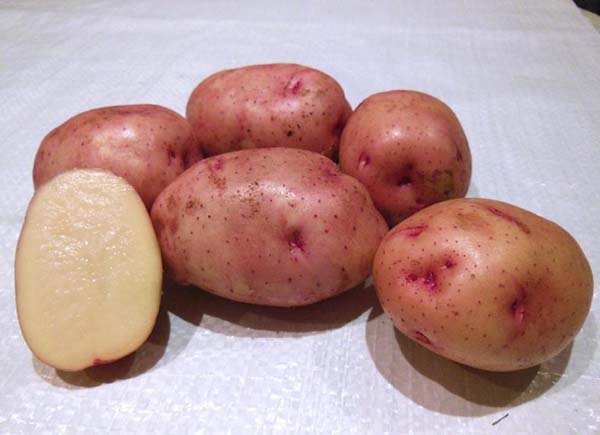
Characteristics of the early Zhukovsky variety:
- ripening period - early (70-80 days), according to other sources, very early (60-80 days);
- the tubers are oval-round;
- the structure of the peel is smooth;
- peel color - pink;
- the color of the pulp is white;
- the depth of the eyes is shallow;
- starch content - 10-12%;
- yield per one hundred square meters - 400-450 kg;
- the number of tubers per bush - 9-15;
- the average weight of 1 tuber is 100-120 g;
- marketability - 90-92%;
- keeping quality is good.
Appearance - bushes of medium height, semi-spreading stem type, the leaf is small, green (glossy), the flowers have a red-violet hue. Berry formation is rare.
Recommended for planting regions: North-West, Central, Volgo-Vyatka, Central black earth, North Caucasian, Middle Volga, Nizhnevolzhsky, Ural, West Siberian, Far East.
Patent holder and / or originator of the variety: FGBNU “All-Russian Research Institute of Potato Farming named after A.G. Lorkha (Russia).
Impala
An early variety, for table use, good yield and taste.
Differs in crop stability under all weather conditions, including high temperature resistance. The main thing is not to overdo it with nitrogen fertilizers.
In the southern regions, it is possible to get two crops at once in 1 season.
Note! When planting, the seed is recommended to germinate. Also, you can not break off the sprouts and do not plant in unheated soil.
It is resistant to cancer and potato nematode, susceptible to late blight and rhizoctonia disease, weakly affected by viral diseases and common scab.
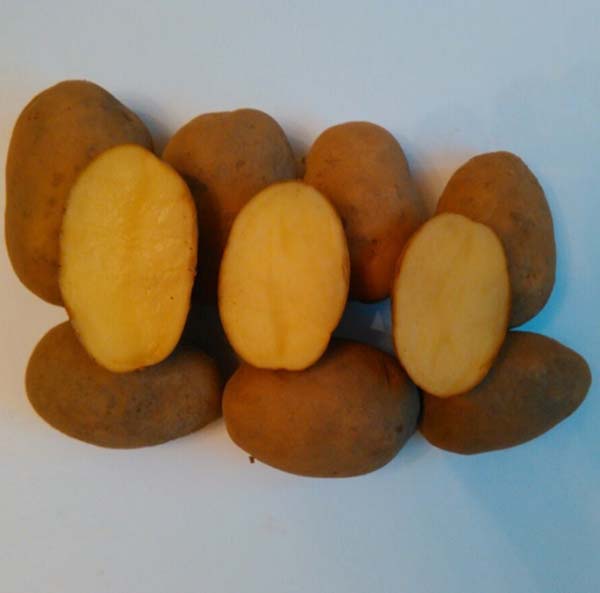
The taste is good. During the cooking process, the pulp does not darken or crumble. Ideal for frying and cooking French fries.
Characteristics of the Impala variety:
- ripening period - early (70-80 days);
- tubers are oval;
- peel color - yellow;
- pulp color - light yellow;
- the depth of the eyes is shallow;
- starch content - 10.5-14.6%;
- yield per hundred square meters - 180-360 kg (maximum - 367 kg);
- the number of tubers per bush - 16-21;
- the average weight of 1 tuber is 88-150 g;
- marketability - 89-94%;
- keeping quality - 90%.

The appearance of the plant is tall, erect. Flowers are white.
Recommended for planting regions: North-West, Central, Volgo-Vyatka, Nizhnevolzhsky.
Patent holder and / or originator of the variety: Agrico U.A. (Holland).
Kamensky
The variety is early maturing, for table use, medium yield and good taste.
It is characterized by early harvest accumulation and leveled tubers with high marketability.
It adapts well to all types of soil. Differs in drought resistance due to the early formation of tubers. Requires loosening of the soil, responds positively to fertilization and watering. The tough leaves of adult plants do not like the Colorado potato beetle.
Resistant to the causative agent of potato cancer. Susceptible to nematode. Medium resistant to late blight pathogen, resistant to wrinkled and banded mosaics, leaf twisting, common scab and rhizoctonia.
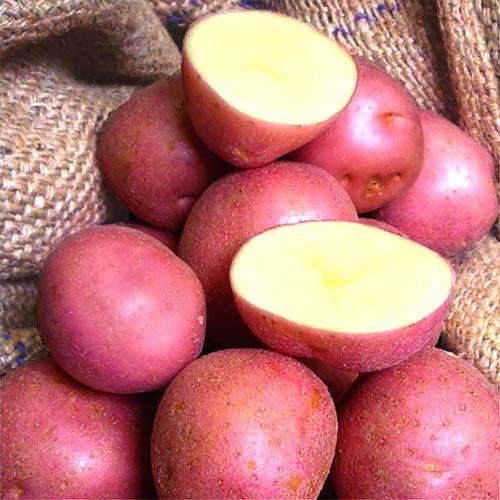
The taste is good. Culinary type B (poor digestibility).
Characteristics of the Kamensky variety:
- ripening period - early (70-80 days);
- the shape of the tubers is elongated-oval;
- the structure of the peel is smooth;
- peel color - red;
- pulp color - light yellow;
- the depth of the eyes is shallow;
- starch content - 12.2-16.8%;
- yield per hundred square meters - 185 kg (maximum up to 252 kg);
- the number of tubers per bush - 15-25;
- the average weight of 1 tuber is 96-108 g;
- marketability - 85-94%;
- keeping quality - 97%.
The appearance of the plant is of an intermediate type, semi-erect. Medium leaf, intermediate type, dark green. Strong edge waviness. The intensity of the anthocyanin coloration of the inner side of the corolla is from medium to strong, the proportion of blue is absent or very small. The inflorescences are large. and red and purple. Berry formation is rare.
Recommended for planting regions: Volgo-Vyatka, Ural, West Siberian.
Patentee and / or originator of the variety: FGBNU "Ural Research Institute of Agriculture" (Russia).
Queen Anne
An early variety for table use, high yield, excellent taste.
Interesting! This particular variety is grown by the President of the Republic of Belarus Alexander Grigorievich Lukashenko in his residence "Drozdy".
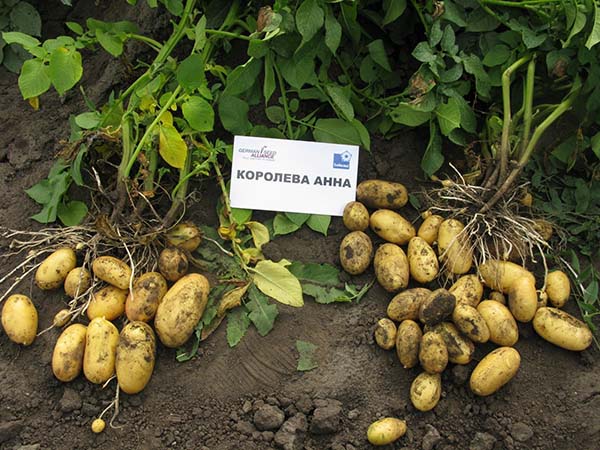
Pre-germination and planting in warm soil is desirable.
Note! When grown in arid regions, it needs abundant watering.
Resistant to the causative agent of potato cancer, golden potato cyst nematode. Resistant to wrinkled striped mosaics and leaf curling. Transport transfers without loss of marketability.
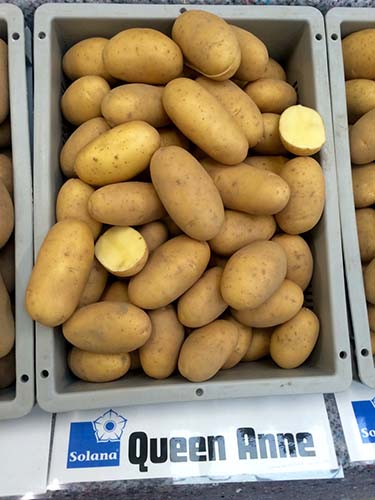
The variety has an excellent taste. Does not darken, does not boil over (weak). Recommended for frying, making soups, salads.
Characteristics of the Koroleva Anna variety:
- ripening period - early (70-80 days);
- the shape of the tubers is elongated-oval;
- the structure of the peel is smooth;
- peel color - yellow;
- the color of the pulp is yellow;
- the depth of the eyes is very shallow or shallow;
- starch content - 13.1-14.4%;
- yield per hundred square meters - 113-304 kg (maximum up to 495 kg);
- the number of tubers per bush - 6-16;
- the average weight of 1 tuber is 84-137 g;
- marketability - 82-96%;
- keeping quality - 93%.
The appearance of the plant is of medium height, stem type, has semi-spreading shoots. Leaves are medium or large, closed, green. Inflorescences are white.
Regions recommended for planting: North-West, Central, Volgo-Vyatka, Central Black Earth Region, North Caucasian, Middle Volga, West Siberian, East Siberian.
Patent holder and / or originator of the variety: Solana GmbH & Co. KG (Germany).
Labella
An early variety, for table use, medium yield, excellent taste.
Resistant to high temperatures during the growing season, has excellent adaptability to climatic conditions and soil types.
Resistant to the causative agent of potato cancer and nematodes. Highly resistant to leaf roll virus.
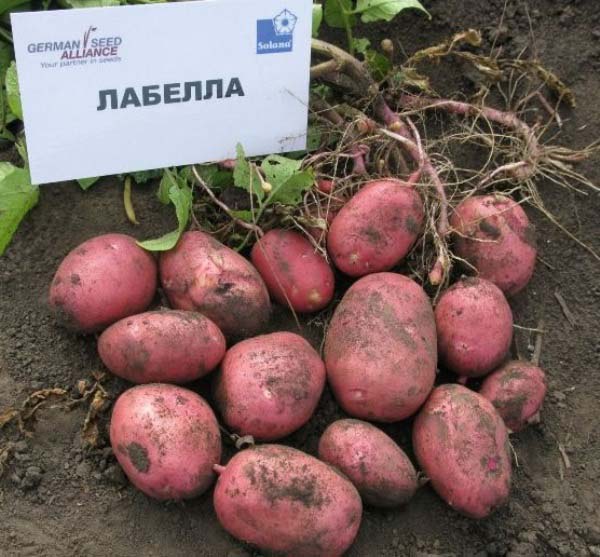
The taste is excellent. The digestibility is average.
Characteristics of the Labella variety:
- ripening period - early (70-80 days);
- the shape of the tubers is elongated-oval;
- the structure of the peel is smooth;
- peel color - red;
- the color of the pulp is yellow;
- the depth of the eyes is shallow to medium;
- starch content - 15.8%;
- yield per hundred square meters - 176-264 kg (maximum up to 342 kg);
- the number of tubers per bush - up to 14;
- the average weight of 1 tuber is 78-102 g;
- marketability - 91-92%;
- keeping quality - 98%.
The appearance of the plant is from medium height to high, leaf type, semi-erect. The leaf is large, intermediate, green. Inflorescences are red-purple.
Recommended for planting regions: Central, North Caucasian, Middle Volga, Ural.
Patent holder and / or originator of the variety: Den Hartigh BV (Holland).
Lyubava
An early variety, for table use, high yield, good taste. Culinary type A (salad type). Does not boil over. The pulp darkens moderately during cooking.
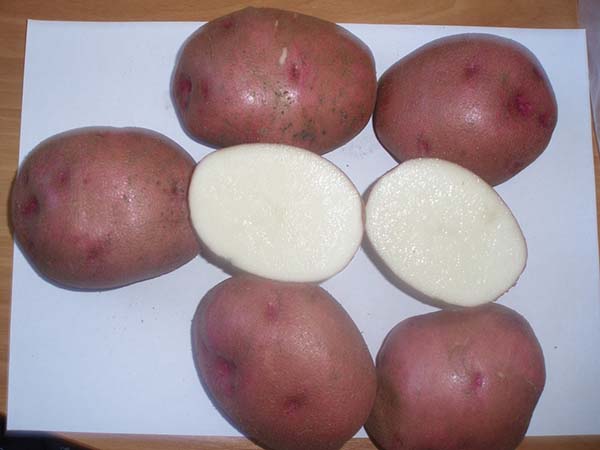
Resistant to the causative agent of potato cancer, rhizoctonia, susceptible to nematode. It is also susceptible in terms of tops and moderately resistant in tubers to the causative agent of late blight. Moderately resistant to common scab.
Characteristics of the Lyubava variety:
- ripening period - early (70-80 days);
- the shape of the tubers is oval-round;
- the structure of the peel is from medium to coarse (according to other sources, it is generally suitable, but flaky at the top);
- peel color - red;
- the color of the pulp is white;
- the depth of the eyes is average;
- starch content - 11.2-16.9%;
- yield per hundred square meters - 288-400 kg (maximum up to 524 kg);
- the number of tubers per bush - 8-15;
- the average weight of 1 tuber is 109-210 g;
- marketability - 80-98%;
- keeping quality is good.
The appearance of the bushes is of medium height, intermediate type, semi-erect. The leaf is small, open, light green. The waviness of the edge is weak. Average gloss. Inflorescences are medium-sized, reddish-purple. Berry formation is rare.
Recommended for planting regions: Ural, West Siberian, East Siberian, Far East.
Patent holder and / or originator of the variety: FGBNU “All-Russian Research Institute of Potato Farming named after A.G. Lorkha (Russia).
Red Scarlet
An early variety, for table use, medium yield, normal (satisfactory) taste.
Prefers to grow in soils with good air permeability. It is optimal to plant tubers with at least 5 or more eyes. Productivity does not fall even with drought and high temperatures during the growing season.All tops should be removed 10 days before harvest. Tubers are formed very amicably (simultaneously).
Resistant to the causative agent of potato cancer, golden potato cyst nematode. Susceptible to late blight pathogen in tops and moderately susceptible to tubers.
Taste properties are within normal limits (taste is satisfactory). During the cooking process, the pulp does not darken, and is also moderately (medium) boiled. Culinary type VS. Suitable for making soups, salads, as well as frying and making chips. Can be used for mashed potatoes and cooking, but not good enough.
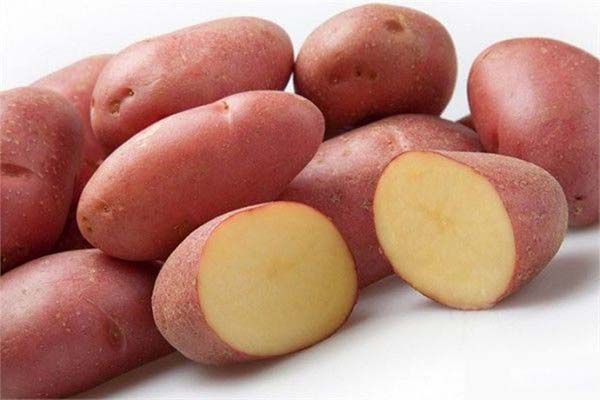
Characteristics of the Red Scarlet variety:
- ripening period - early (70-80 days);
- the shape of the tubers is elongated-oval;
- the structure of the peel is smooth;
- peel color - red;
- the color of the pulp is yellow;
- the depth of the eyes is shallow;
- starch content - 10.1-15.6%;
- yield per hundred square meters - 164-192 kg (maximum 270 kg);
- the number of tubers per bush - up to 15;
- the average weight of 1 tuber is 56-102 g;
- marketability - 82-96%;
- keeping quality - 98%.
The appearance of the plant is low, intermediate type, semi-erect. Leaves are medium-sized, green. Inflorescences are medium-sized, reddish-purple.
Recommended for planting regions: North-West, Central, Volgo-Vyatka, TsChO, West Siberian.
Patent holder or originator of the variety: HZPC Holland B.V. (Holland).
Riviera
An early variety, for table use, high yield, good taste.
Due to early ripening, the plant manages to form fruits before the hot season, therefore, does not need additional watering. In addition, the Riviera forms a powerful root system, which allows it to fully provide the shoots and tubers with moisture. It prefers to grow on light soils where it gives a stable annual yield. Differs in drought resistance and resistance to mechanical damage.
Planting should be carried out only in well-heated soil and only with germinated tubers.
Resistant to the causative agent of potato cancer and nematodes. Susceptible to late blight pathogen, resistant to banded mosaic.
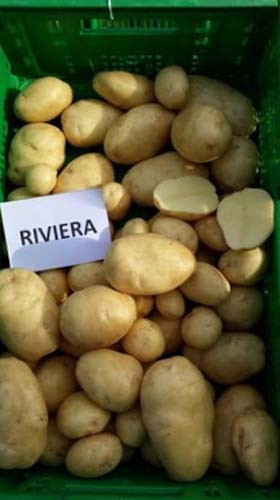
The taste is good. As it cooks, the pulp becomes crumbly.
Characteristics of the Riviera variety:
- ripening period - early (70-80 days);
- tubers are oval;
- the structure of the peel is rough;
- peel color - light beige;
- pulp color - cream;
- the depth of the eyes is shallow to medium;
- starch content - 11.5-15.9%;
- yield per hundred square meters - 189-366 kg (maximum up to 465 kg);
- the number of tubers per bush - 8-12;
- the average weight of 1 tuber is 101-177 g;
- marketability - 80-96%;
- keeping quality - 94%.
Forms strong, but low or medium semi-erect or spreading shoots 70-80 cm high, which practically do not bloom. Medium to large leaf, light green.
Recommended for planting regions: Central, TsChO, North Caucasian.
Patent holder and / or originator of the variety: Agrico U.A. (Holland).
Rosara
An early variety, versatile, high-yielding, good taste.
Regardless of climatic conditions, it is able to give a stable harvest. Not damaged during transportation. It is characterized by amicable ripening of tubers.
When grown, responds well to watering, fertilization.
Resistant to cancer and potato nematode, slightly affected by late blight and common scab.
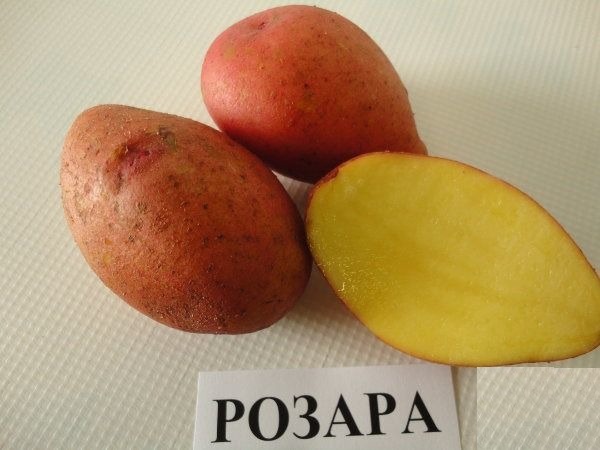
Taste good or great. In the process of cooking, it almost does not boil down, so the variety is ideal for salads, frying, cooking french fries, chips. Not suitable for mashed potatoes and cooking.
Characteristics of the Rosara variety:
- ripening period - early (70-80 days);
- tubers are oblong-oval;
- peel color - red;
- the color of the pulp is yellow;
- the depth of the eyes is shallow;
- starch content - 12.1-15.8%;
- yield per one hundred square meters - 202-310 kg (maximum up to 415 kg);
- the number of tubers per bush - 15-20;
- the average weight of 1 tuber is 81-115 g;
- marketability - 91-99%;
- keeping quality - 97% (good).
The appearance of the plant is a bush of medium height, semi-spreading. The flowers are red-purple.
Recommended for planting regions: North-West, Volgo-Vyatka, Central Black Earth Region, North Caucasian, Middle Volga, Ural, West Siberian, East Siberian, Far East.
Patent holder and / or originator of the variety: SaKa Pflanzenzucht Gbr (Germany).
Luck
Early variety, table variety, high-yielding, normal (satisfactory) taste.
Productivity is stable in a favorable climate for crops. The choice of soil does not matter. It tolerates well both waterlogging and lack of moisture in the soil.
Moderately susceptible to late blight in tops and moderately resistant to tubers. Not damaged during transportation (resistant to mechanical damage).
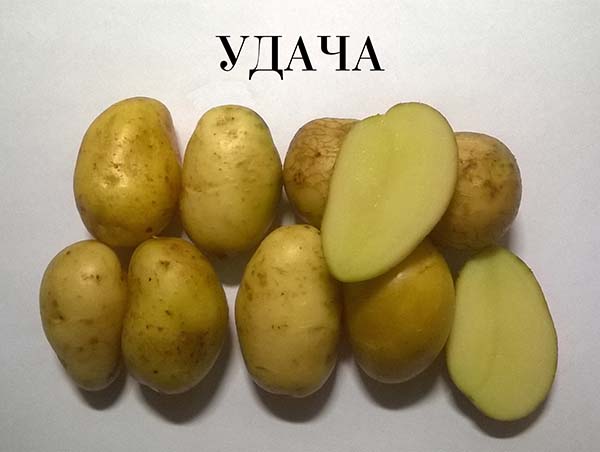
Fair to good taste. Culinary type B. The digestibility is weak, the pulp darkens slightly. Suitable for making soups and salads, as well as frying, making fries and chips.
Characteristics of the variety Luck:
- ripening period - early (70-80 days);
- the shape of the tubers is round-oval;
- the structure of the peel is smooth;
- peel color - light beige (cream);
- the color of the pulp is white;
- the depth of the eyes is shallow;
- starch content - 12-15%;
- yield per hundred square meters - 300-500 kg;
- the number of tubers per bush - up to 10-14;
- the average weight of 1 tuber is 100-150 g;
- marketability - 96%;
- keeping quality is good;
The appearance of the plant is medium, semi-spreading. Leaves with large lobes, dark green. Inflorescences are snow-white. Berry formation is rare.
Recommended regions for planting: North-West, Central, Volgo-Vyatka, Central Black Earth Region, North Caucasus, Middle Volga, Ural, Far East.
Patent holder and / or originator of the variety: FGBNU “All-Russian Research Institute of Potato Farming named after A.G. Lorkha (Russia).
Uladar
An early variety, for table use, high yield, good taste.
Not picky about the composition of the soil, it can be grown on light and medium-sized soils. Reacts well to mineral fertilizing.
Differs in early tuberization in the first half of the growing season.
Resistant to the causative agent of potato cancer, nematode, wrinkled and banded mosaic. Moderately resistant on leaves and tubers to the causative agent of late blight, leaf rolling, Moderately susceptible to common scab and rhizoctonia. Tubers are moderately resistant to mechanical damage.
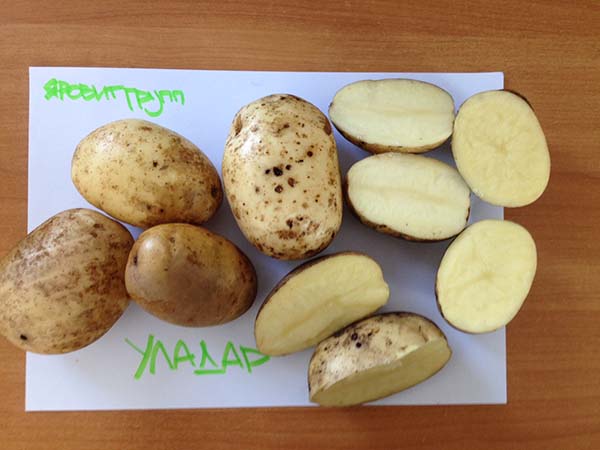
Good or excellent taste. Culinary type B. The boil-off is weak. Uladar is great for frying and cooking chips.
Characteristics of the Uladar variety:
- ripening period - early (70-80 days);
- the shape of tubers - from oval to oval-rounded (elongated-oval);
- the structure of the peel is smooth;
- peel color - yellow;
- pulp color - light yellow (creamy yellow);
- the depth of the eyes is very shallow;
- starch content - 13.8-17.5%;
- yield per hundred square meters - 127-353 kg (maximum up to 424 kg);
- the number of tubers per bush - 6-11;
- the average weight of 1 tuber is 91-140 g;
- marketability - 90-95%;
- keeping quality - 94%.
The variety is characterized by bushes of medium size, intermediate type, semi-erect. Forms thin stems with medium-sized leaves, slight waviness of the edge. Inflorescences are red-purple.
Recommended planting regions: Northwest, Central.
Patent holder and / or originator of the variety: RUE "Scientific and Production Center of the National Academy of Sciences of Belarus for Potato and Fruit Growing" (Belarus).
Other early varieties
There are a lot of early potato varieties, here is a list of the names of all officially registered ones:
Important! The list is long, but you can scroll through it quickly enough, suddenly your eye catches on a familiar name that you have heard somewhere or once recommended to you.
- Axenia;
- Diamond;
- Alova;
- Antonina;
- Arosa;
- Arrow;
- Artemis;
- Baron;
- Bashkir;
- Bellaprim;
- Bonus;
- Bryansk early;
- Warmas;
- Vega;
- Spring is white;
- Explosive;
- Vitesse;
- Gloria;
- Goryanka;
- Gulliver;
- Daryonka;
- Dolphin;
- La Gioconda;
- Ermak improved;
- Fun;
- Zorachka;
- Inara;
- Spark;
- Kaluga;
- Karatop;
- Caruso;
- Kibitz;
- Kislovodsky;
- Colette;
- Corolla;
- Beauty;
- Krasnoyarsk early;
- Sturdy;
- Christelle;
- Merchant;
- Lapis lazuli;
- Lapperla;
- Latona;
- Lady Blanca;
- Lady Lenora;
- Lady Olympia;
- Leonie;
- League;
- Leader;
- Lomonosovsky;
- Lyudmila;
- Suite;
- Madeline;
- Mother;
- Miranda;
- Bear;
- Molly;
- Mostovsky;
- Madison;
- Natasha;
- Neptune;
- Newton;
- Flint;
- In memory of Kulakov;
- In memory of Osipova;
- Panthers;
- Penza early ripening;
- Povin;
- Povirovets;
- Pogarsky;
- Flight;
- Priobsky;
- Pushkinets;
- Ranomi;
- Reggae;
- Red Lady;
- Rikea;
- Rosanna;
- Saxon;
- Salin;
- Samara;
- Sandrine;
- Sarovsky;
- Northern;
- Serpanok;
- Fast-growing;
- Bullfinch;
- Sprint;
- Timer;
- Timo Khankkiyan;
- Tulun early;
- Ural early;
- Duckling;
- Early morning;
- Felox;
- Figaro;
- Fidelia;
- Fioretta;
- Fresco;
- Khibiny early;
- Kholmogorsky;
- Sheri;
- Al Mundo;
- Anniversary;
- Yuna;
- Yakutian woman;
- Jarl.
By the way! Many ratings of the earliest potato varieties contain Dutch variety Ariel, but it is not officially registered, which means that it is not approved for use in Russia. However, this does not mean at all that you cannot plant it on your site if you find it at garden fairs, because it is quite popular and loved by many summer residents.
Thus, the first step in growing such a wonderful crop as potatoes should be the correct choice of the early variety that best suits your needs and requirements, and also meets the agro-climatic conditions of your region and the characteristics of your particular site.

